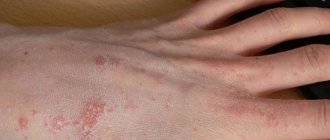Chickenpox has traditionally been considered a “children’s” disease, but this does not mean that it does not threaten adults. Chickenpox in adults develops much more acutely and dangerously than in childhood. If in childhood chickenpox occurs in a mild form, then in adults it is more likely to be moderately severe or severe. Every year and closer to mature, old age, chickenpox is at greater and greater risk of causing complications.
Causes of chickenpox in adults
Once you have had chickenpox, you no longer have to worry about this infection. A person develops a strong immune system from chickenpox. That is why it is not fiction, but absolutely real, that stories about familiar children being taken to visit each other as soon as one gets infected with chickenpox.
The chickenpox virus belongs to the herpevirus family and is called Varicella zoster. It spreads by airborne droplets and can travel meter distances in the air. Due to its small size, the virus easily penetrates from room to room, including through ventilation. The source of the virus is a person who is in a state of active disease or only at the end of the incubation period. The incubation period is estimated at 10-21 days from the moment of infection with the virus. Although the virus is characterized as highly infectious and volatile, it is not at all resistant to the external environment, which means that third parties and objects are not the source of infection.
From the first day of symptoms appearing, a person needs strict quarantine, since the risk is already the one who follows him in the elevator, corridor, or similar premises.
At the same time, contact with a sick person for an adult and even a child does not necessarily mean infection. It's a matter of immunity. Of course, the immunity of an adult is stronger and more developed than that of a child, but sometimes it also weakens. The body's protective functions may decrease due to a severe illness, ongoing treatment, severe stress and other unfavorable factors.
Another reason for the occurrence of chickenpox in adults lies in contact with a patient with herpes zoster in the acute stage. Being a virus related to herpes zoster, chickenpox can again strike a person with suppressed immunity.
Pregnant women are at particular risk. Vaccination of pregnant women is not carried out. If for the woman herself the disease will proceed with exactly the same risks as for other adults, then the virus poses a particular danger directly to the fetus. As with most other infectious diseases, in the case of chickenpox, the greatest risks occur in the first trimester of pregnancy and the days before birth:
- at the beginning of pregnancy, the chickenpox virus can lead to both involuntary abortion, miscarriage, stillbirth, and a variety of congenital pathologies;
- from a woman giving birth while sick, the virus can be transmitted to the newborn, who develops chickenpox pneumonia; it is dangerously fatal.
If a woman has had chickenpox at the beginning of pregnancy, then subsequent ultrasound examinations and other diagnostic methods are aimed at identifying or excluding congenital anomalies in the fetus. If the virus reaches the end of the term, an attempt can be made to delay childbirth. As a last resort, immunoglobulins are used, which contain antibodies to the causative agent of the disease.
Features during pregnancy
Chickenpox during pregnancy is extremely dangerous; the disease poses a threat not only to the woman, but also to the fetus. The result of the disease can be a miscarriage if the infection occurs before the 12th week.
When infected with chickenpox in the first trimester, the disease almost always negatively affects the development of the fetus - pathologies and deformities, diseases of the bone and nervous system, and disturbances in the formation of sensory organs can develop. If an ultrasound reveals such problems, the woman is recommended to have an artificial termination of pregnancy.
If chickenpox is detected in a pregnant woman, termination of pregnancy is recommended.
After 20 weeks, the virus does not particularly affect the condition of the mother and child, but a relapse may occur immediately before birth. Infection with chickenpox in the later stages provokes the development of pneumonia, which is often fatal for a newborn.
Important!
Women who have not had chickenpox are recommended to get vaccinated when planning pregnancy.
Prevention of chickenpox in adults
The most reliable way to exclude the possibility of chickenpox is to have a history of the disease. That is, having been ill only once - in childhood, youth and even adulthood - a person develops a strong immunity that does not allow him to get sick again. At the same time, chickenpox does not go away without a trace. The virus is “remembered” by nerve endings, and under unfavorable circumstances it manifests itself as shingles.
If you think that it is possible and necessary to get chickenpox, that this is an affordable way to prevent its severe form in adulthood, then remember that exacerbations of shingles are not limited to one time. This disease is no less unpleasant than smallpox itself. It is accompanied by unbearable burning pain.
To prevent chickenpox or shingles later, vaccination is an excellent method of prevention. The immunity formed from it cannot be called lifelong, but it is characterized as stable and long-lasting. A blood test from a vein will show whether a vaccine is needed at the moment, whether antibodies to the Varicella zoster virus remain in the blood after a previous vaccination. If antibodies are present, there is no need for vaccination.
The vaccine contains a live weakened strain. It is performed in two injections, 1-2 months apart. Suitable for both routine and emergency vaccination. The latter is undertaken in the next 72 hours after first contact with the patient. Vaccination is advisable for both adults and children over one year of age. It is appropriate to vaccinate against chickenpox in combination with vaccinations against measles, mumps and rubella.
The chickenpox vaccination can cause a number of side effects. Among the most common, but not at all obligatory, side effects are mild symptoms of chickenpox and an increase in body temperature. However, this is not a reason to refuse vaccination. A real reason to think about the need for vaccination would most likely be an allergic reaction, in particular to gelatin and other components of the vaccine.
How to speed up recovery
Having determined how many people suffer from chickenpox on average, let’s try to find out whether it is possible to make the disease go away faster. According to doctors, in order to speed up recovery, it is enough to:
- Adjust the patient’s diet by including a large amount of vegetables, fruits, fruit drinks in the diet and excluding spicy, too salty, fried and fatty foods.
- Change bedding and underwear used by a sick person daily.
- Make sure that the patient does not get too cold, sweat, or scratch the rash.
- Dress sick children in clothes with long legs and sleeves.
- Every day, treat the patient’s pockmarks with disinfectant solutions..
- Take antipruritic, antipyretic, antiviral and antihistamine drugs for a disease that occurs in a complicated form.
- Make sure that the sick person maintains bed rest for 6-8 days from the day the first symptoms of the pathological process appear.
- Once every 4 hours, carry out a light wet cleaning of the room occupied by the patient.
How many days will it take to recover from chickenpox if the above conditions are met? This depends on the form of the disease, the age of the patient and the state of his immune system. In most cases, following these recommendations allows you to shorten the active stage of the disease by 3-5 days. In cases where home treatment does not bring the expected results, inpatient therapy may be necessary.
Chickenpox symptoms in adults
The symptoms of chickenpox in adults are in many ways similar to the manifestations of the disease in childhood. However, each symptom is much more difficult for the body to bear.
Chickenpox begins suddenly in adults, with an acute outbreak. Among the expressive signs:
- general weakness and body aches,
- headache,
- nausea, sometimes vomiting, indicating the development of intoxication in the body,
- fever - the temperature rises sharply to 39-40°C,
- a specific sign of chickenpox in adults is considered to be enlarged lymph nodes - behind the ear and cervical - they reach sizes visible to the eye, become tense and painful,
- and the most obvious sign of smallpox is a rash.
The rash during chickenpox in adults, as well as in children, has a certain specificity:
- it itches and burns very much, literally depriving a person of sleep;
- starts from the stomach and thighs;
- spreads upward along the shoulders and chest;
- last of all it affects the face and scalp;
- can spread not only over the skin, but also through the mucous membranes of the body - the oral cavity and the mucous membrane of the pharynx, sometimes even the mucous membrane of the genital organs;
- the rash that has just appeared is a small red bump that gradually transforms into a transparent vesicle;
- transparent bubbles at their base remain red in color and contain liquid inside;
- bursting easily, the bubbles turn into moist sores (vesicles), which are covered with a thin crust on top;
- Several weeks may pass until the crust falls off on its own, which is considered the end of the disease.
The formation of the rash lasts 3-5 days. During this time, the first tubercles have time to burst and turn into ulcers, while the latter are just appearing. Often, red spots, bumps, and dried crusts can be observed on the patient’s body at the same time. A person ceases to be potentially dangerous to others as soon as the last crust of the burst vesicle falls off.
Chickenpox stages
- 1. The first stage is the incubation period in humans, it can also be called latent. At this stage, the virus enters the body through the upper respiratory tract, penetrates the epithelial cells of the mucous membrane, then the virus enters the blood, spreading throughout the body. There are no visible symptoms during this period, but sometimes sensations similar to a cold are possible: sore throat, slight fever. It is at the beginning of this period that you can get vaccinated and reduce the unpleasant consequences of chickenpox. The duration of the illness during this period is 21 days.
- 2. The second stage is the prodromal period, characterized by a sharp increase in temperature, chills, headache, body aches, and loss of appetite. The symptoms are very much like the flu. Many people confuse these two diseases before the first rash and begin to treat it incorrectly. Only a doctor should diagnose the patient’s condition and prescribe treatment.
At home, you can relieve aches and headaches with an antipyretic drug, but in no case, never take aspirin or aspirin-containing medications during chickenpox!
Proper initiation of treatment is the key to the successful course of chickenpox, the absence of complications and a speedy recovery.
Complications of chickenpox in adults
The most common complication of chickenpox in adults is skin infection resulting from vigorous scratching of the itchy rash. Ideally, you don’t need to touch the rash at all - scratch it, tear off the scabs, squeeze out the contents (especially during sleep) - but this is quite difficult. You can damage the bubbles by simply wiping your body with a towel. It is necessary to exercise caution and maximum care with rashes in order to prevent infection, suppuration, and sometimes necrotic processes in the pustules. If you tear off the crusts from the pustules prematurely, a so-called pockmark forms, which over time turns into a scar. You must be prepared for the fact that the rash from chickenpox in adults lasts longer, spreads more abundantly, and the drying and rejection of the crusts also takes longer.
There is always a risk of such severe forms of chickenpox as hemorrhagic and gangrenous. The first occurs due to damage to the blood vessels, and then the contents of the vesicles contain blood impurities. The second is caused by rotting processes inside the rash, and as a result, deep ulcers are formed with the highest risk of infection.
Other sources of infection on the skin and mucous membranes in the case of chickenpox in adults risk being non-compliance with banal hygiene measures, scratching the rash with dirty hands/nails, ignoring the use of special healing and antiseptic agents for external use, etc. The risk of infected sores in adults is much higher than in children.
It is important to note that infection of pustules is not the only danger caused by the varicella zoster virus. In adults, and even more so in adolescence and old age, the risk of developing the following complications of chickenpox increases significantly:
- chickenpox pneumonia - penetration of the virus into the bronchopulmonary system is more often observed in persons with impaired immune systems, especially in adolescents and pregnant women;
- loss of vision, optic neuritis - if the smallpox virus spreads to the cornea due to poor hygiene (for example, if you rub your eyes with your hands immediately after scratching the papules), rashes can appear even on the white of the eye, as well as on the temples, under the eyes and above over the centuries; in this case, scars will remain in place of the bubbles, this affects the state of vision up to its complete loss;
- arthritis or inflammation of the joints occurs if the virus penetrates the joint capsules, the joints themselves; pain, as well as muscle aches, goes away along with the neutralization of the rash;
- meningitis and encephalitis, damage to the cerebellum and cranial nerve nuclei - an unfavorable course of chickenpox that occurs when the chickenpox virus reaches nerve cells and meninges; the main symptoms are headache, nausea, convulsions, loss of consciousness, impaired coordination of movements and sense of balance, paralysis of the facial muscles;
- chickenpox tracheitis or laryngitis - the main course of chickenpox in adults, less often in children, is accompanied by cough and sore throat; this will occur if rashes develop on the mucous membranes of the respiratory tract and pharynx, and they are profuse;
- acute stomatitis - plagues the patient when chickenpox ulcers are localized on the oral mucosa and gums;
- vulvitis in women and balanoposthitis in men develop when a blistering rash occurs on the genitals.











